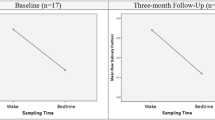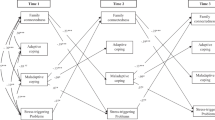Abstract
The authors examined the relations between mobilizing coping, the tendency for families to respond to problems by seeking community-based assistance, and psychological distress and cortisol activity in homeless adolescents (12–17 years) who were displaced by Hurricane Katrina (n = 50) as compared to demographically matched controls (n = 31). Perceptions of family mobilizing covaried with lower cortisol activity, a physiological indicator of recurrent stress exposure and long-term changes in hypothalamic pituitary adrenal regulation and, in this study, greater internalizing symptoms. Follow-up analyses suggested that mobilizing coping partially mediated the relation between hurricane exposure and lower cortisol. Further research is needed to accurately model biological and psychological consequences of the strategies that families use for dealing with ordinary and extraordinary stressors.
Similar content being viewed by others
References
Baron, R. M., & Kenny, D. A. (1986). The moderator-mediator variable distinction in social psychological research: Conceptual, strategic, and statistical considerations. Journal of Personality and Social Psychology, 51, 1173–1182.
Bonne, O., Brandes, D., Segman, R., Pitman, R. K., Yehuda, R., & Shalev, A. Y. (2003). Prospective evaluation of plasma cortisol in recent trauma survivors with posttraumatic stress disorder. Psychiatry Research, 119, 171–175.
Burke, H. M., Fernald, L. C., Gertler, P. J., & Adler, N. E. (2005). Depressive symptoms are associated with blunted cortisol stress responses in very low-income women. Psychosomatic Medicine, 67, 211–216.
Campbell, R., Sefl, T., Barnes, H. E., Ahrens, C. E., Wasco, S. M., & Zaragoza-Diesfeld, Y. (1999). Community services for rape survivors: Enhancing psychological well-being or increasing trauma? Journal of Consulting and Clinical Psychology, 67, 847–858.
Cohen, J., & Cohen, P. (1983). Applied multiple regression/correlation analysis for the behavioral sciences (2nd ed.). Hillsdale, NJ: Lawrence Erlbaum Associates.
Cohen, S., Doyle, W. J., & Baum, A. (2006). Socioeconomic status is associated with stress hormones. Psychosomatic Medicine, 68, 414–420.
Delahanty, D. L., Nugent, N. R., Christopher, N. C., & Walsh, M. (2005). Initial urinary epinephrine and cortisol levels predict acute PTSD symptoms in child trauma victims. Psychoneuroendocrinology, 30, 121–128.
El-Sheikh, M., Buckhalt, J. A., Erath, S. A., Granger, D. A., & Mize, J. (2008). Cortisol and children’s adjustment: The moderating role of sympathetic nervous system activity. Journal of Abnormal Child Psychology, 36, 601–611.
Flinn, M. V., Quinlan, R. J., Turner, M. T., Decker, S. D., & England, B. G. (1996). Male-female differences in effects of parental absence on glucocorticoid stress response. Human Nature, 7, 125–162.
Ginexi, E. M., Weihs, K., Simmens, S. J., & Hoy, D. R. (2000). Natural disaster and depression: A prospective investigation of reactions to the 1993 Midwest floods. American Journal of Community Psychology, 28, 495–518.
Kaniasty, K., & Norris, F. H. (1995). Mobilization and deterioration of social support following natural disasters. Current Directions in Psychological Science, 4, 94–98.
Kreuger, L., & Stretch, J. (2003). Identifying and helping long-term child and adolescent disaster victims: Model and methods. Journal of Social Service Research, 30, 93–108.
McCubbin, H., Larsen, A., & Olson, D. (1987). F-COPES Family crisis oriented personal evaluation scales. In H. I. McCubbin & A. I. Thompson (Eds.), Family assessment inventories for research and practice (pp. 193–207). Madison, WI: University of Wisconsin-Madison.
Miller, G. E., Chen, E., & Zhou, E. S. (2007). If it goes up, must it come down? Chronic stress and the hypothalamic-pituitary-andrenocortical axis in humans. Psychological Bulletin, 133, 25–45.
Ozer, E. J., Best, S. R., Lipsey, T. L., & Weiss, D. S. (2003). Predictors of posttraumatic stress disorder and symptoms in adults: A meta-analysis. Psychological Bulletin, 129, 52–73.
Radloff, L. S. (1977). The CES-D scale: A self-report depression scale for research in the general population. Applied Psychological Measurement, 1, 385–401.
Reynolds, C. R., & Richmond, B. O. (1978). “What I think and feel:” A revised measure of children’s manifest anxiety. Journal of Abnormal Psychology, 6, 271–280.
Rosenberg, M. (1965). Society and the adolescent self-image. Princeton, NJ: Princeton University Press.
Sobel, M. E. (1988). Direct and indirect effect in linear structural equation models. In J. S. Long (Ed.), Common problems/proper solutions: Avoiding error in quantitative research (pp. 46–64). Beverly Hills, CA: Sage.
Sumer, N., Karanci, A. N., Berument, S. K., & Gunes, H. (2005). Personal resources, coping selfefficacy, and quake exposure as predictors of psychological distress following the 1999 earthquake in Turkey. Journal of Traumatic Stress, 18, 331–342.
Travis, J. (2005). Hurricane Katrina: Scientists’ fears come true as hurricane floods New Orleans. Science, 309, 1656–1659.
Uchino, B. N., Cacioppo, J. T., & Kiecolt-Glaser, J. K. (1996). The relationship between social support and physiological processes: A review with emphasis on underlying mechanisms and implications for health. Psychological Bulletin, 119, 488–531.
Vernberg, E. M., La Greca, A. M., Silverman, W. K., & Prinstein, M. J. (1996). Prediction of posttraumatic stress symptoms in children after Hurricane Andrew. Journal of Abnormal Psychology, 105, 237–248.
Vigil, J. M., & Geary, D. C. (2008). A preliminary investigation of family coping styles and psychological wellbeing among adolescent survivors of Hurricane Katrina. Journal of Family Psychology, 22, 176–180.
Wasserstein, S. B., & La Greca, A. M. (1998). Hurricane Andrew: Parent conflict as a moderator of children’s adjustment. Hispanic Journal of Behavioral Sciences, 20, 212–224.
Weiss, D., & Marmar, C. (1997). The Impact of Event Scale-Revised. In J. Wilson & T. Keane (Eds), Assessing psychological trauma and PTSD (pp. 399–411). New York: Guildford.
Author information
Authors and Affiliations
Corresponding author
Rights and permissions
About this article
Cite this article
Vigil, J.M., Geary, D.C. An Exploratory Analysis of Family Coping Styles and Psychobiological Distress Among Adolescents Affected by a Large-Scale Disaster. Journ Child Adol Trauma 2, 81–89 (2009). https://doi.org/10.1080/19361520902861905
Received:
Revised:
Accepted:
Published:
Issue Date:
DOI: https://doi.org/10.1080/19361520902861905




